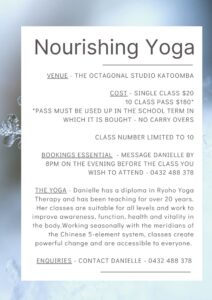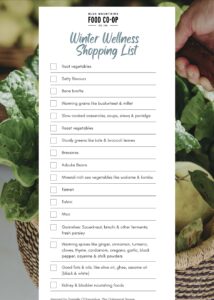Traditional societies and tribes the world over have long acknowledged, celebrated and honoured all that nature bestowed on them at each change of season. Attuned to the natural world around them, they would instinctively discern what was needed to support themselves and their communities through the cycles of the year. In modern Western lifestyles, we often live more removed from the elements and face a bombardment of contradictory narratives. As a result, we can feel disconnected and overwhelmed, and forget to notice the simple truths that surround us in nature.
We can draw inspiration from these ancient healing traditions by opening our attention to our natural surrounds to find seasonal clues as to what may be most appropriate and supportive for us. If we look to nature now, we can observe that many trees have lost their leaves, perennial plants have died off and trees and plants have re-directed their energy and resources inwards and down to their roots. Likewise, we can fortify ourselves by conserving and pulling our energy inwards and downwards, cultivating an inner warmth, and resting and rejuvenating in these cooler months.
Each season brings with it a series of gifts in the form of foods available to us, energies that are present and opportunities to embrace. The Eastern healing philosophies from China and Japan have a deep and holistic way of looking at the human body in relation to its surroundings. They associate winter with the water element, which brings with it all the qualities of water: effortless flow, deep stillness, and amazing strength, to name a few. These Eastern traditions also recognise organs and their corresponding meridians — pairs of which are more accessible in each season. With winter comes the enhanced opportunity to nourish and bring deep healing to the kidney and bladder organs, meridians and energy systems, and their range of qualities and aspects.
Compliment this with eating seasonal foods and using the most appropriate preparation methods for the winter climate and you will have within your power a wonderful holistic and age-old system for health and wellness. Food really can be your medicine; and if you fill your diet with medicinal wholefoods, you may rarely need medicine!
Winter foods and cooking methods
The main aim at this time of year is to build internal warmth and nourish all aspects of the water element. Certain foods and cooking methods can help us achieve this:
- eating root vegetables, salty flavours, bone broths and warming grains like buckwheat and millet
- practicing cooking methods that generate lots of heat like slow cooked casseroles, stews and porridge
- making soups with chunky-cut vegetables and grains like barley
- roasting vegetables
- sautéing sturdy greens like kale and broccoli leaves or stirring them into broths.
Brassicas, which grow though winter and become sweet with the frosts, are also wonderful winter additions; as are adzuki beans, which are renowned for their kidney nourishing properties. One of my personal favourite kidney-medicine meals is a simple stew made with cooked adzukis, flavoured with tamari and ginger.
Buckwheat, with its warming effect in the body and its high content of the bioflavonoid ‘rutin’ that nourishes the capillaries and boosts circulation, is also especially suited to winter and cold weather consumption. A steaming hot porridge of soured* buckwheat and oats — topped with a condiment of tahini, miso and a large pinch of finely grated fresh ginger mixed with water into a runny sauce — makes a nourishing, savory breakfast that ticks all the boxes for winter goodness.
Winter foods should be heavier and denser with nutrition. More fats and oils can be tolerated in winter, and one need not lament a little gain in insulating weight. A short spring fast should see it fall off as the weather warms and the energies start to rise.
Nourishing bones and the nervous system
Another important focus in these cooler months is the nourishment of bones and the nervous system, both of which need minerals to flourish. Adding small, regular amounts of mineral-rich sea vegetables, like wakame and kombu, are vital in winter — but take care not to overdo them as they do have cooling properties. You can counteract cooling foods and bring heat, depth and flavour to your dishes by adding warming spices like ginger, cinnamon, turmeric, cloves, thyme, cardamom, oregano, garlic, black pepper, cayenne and chilli powders; many of these herbs and spices also contain immune boosting elements, making them great regular additions to your winter meals.
Winter tips and tricks
- Rest well and nourish yourself deeply
- Limit raw, high sugar and cooling foods
- Feast on soups, stews and casseroles
- Build your bones and tone your nervous system with mineral rich foods like sturdy greens, sea vegetables, tamari, whole grains and root vegetables
- Regularly add miso, sauerkraut, kimchi and other ferments to your meals to keep your gut and immune system primed and healthy
- Garnish your hot meals with fresh parsley, citrus or sauerkraut to stay topped up with vitamin C
Tuning into the gifts winter has to offer
The long, cold winter nights give us the opportunity to rest deeply, which recharges our kidney and adrenal energies. We can spend our indoor time creatively and cultivate inner warmth with food, movement, meditation and breathing practices. A focus on lengthening and strengthening the spine is especially helpful in calming the nervous system and helping us feel strong and supported. The ultimate gift in winter is the ability to enjoy the profound stillness that abounds when the world outside is silent and the body feels nourished, calm and strong.
Written by Danielle O’Donoghue, Co-owner & Co-founder of The Octagonal Space
*Souring grains makes them more easily digestible and free up their valuable nutrients. To sour, soak them overnight in warm water with 1 tablespoon of apple cider vinegar.
About the Author

Danielle is an Upper Blue Mountains-based holistic health coach, yoga teacher and co-owner/ co-founder of The Octagonal Space. She facilitates seasonal cleanses, retreats and cooking classes. Danielle is also trained in and teaches Ryoho Yoga, a Japanese style of therapeutic movement that activates meridians and restores balance and function in the body. With 25 years of teaching experience, she offers a weekly timetable of morning and evening yoga classes from her home studio in Katoomba.
Would you like to learn more about eating, living and practicing embodiment/ movement aligned with the seasons? For more information about this and upcoming seasonal cooking and yoga classes, and other happenings in The Octagonal Space, contact Danielle via email
Winter Wellness Shopping List
Inspired by Eating for Winter Wellness by Danielle O’Donoghue, we’ve designed a handy Winter Wellness Shopping List It’s free and available as a printable download below.





